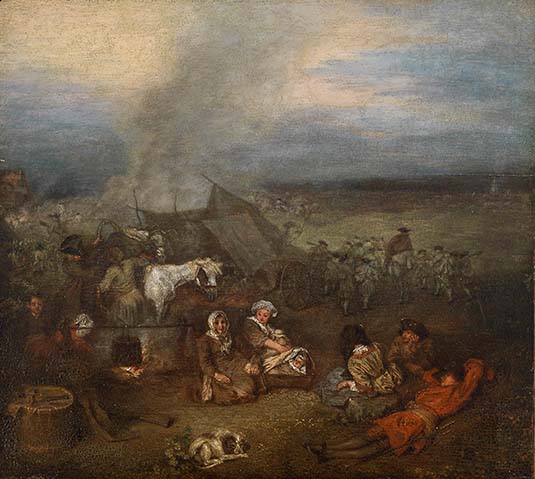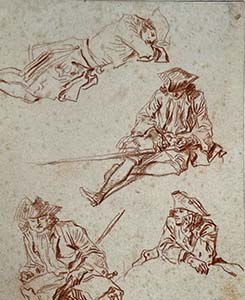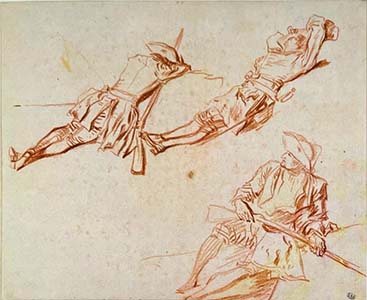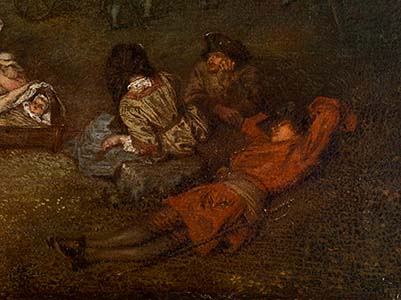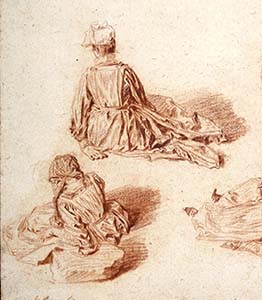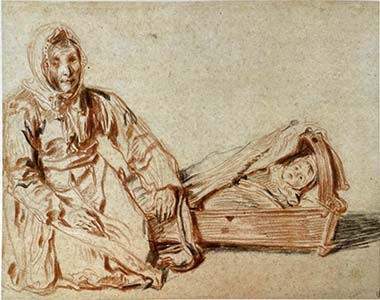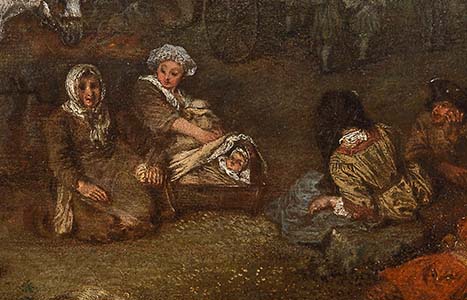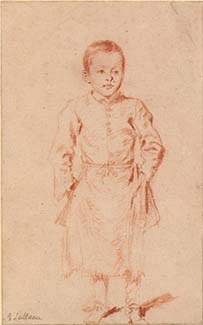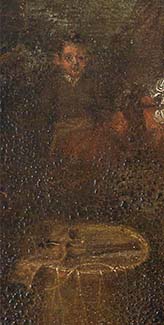
- Home Page
- Accepted
Paintings & Copies - Doubtful
Attributions - Doubtful Textual References
- Alternative
Titles - Collectors &
Museums - Bibliography
- Search Abecedario
- Watteau &
His Circle
L’Escorte d’équipages
Paris, collection of Lionel and Ariane Sauvage
Oil on panel
28.2 x 31.4 cm
ALTERNATIVE TITLES
Un Accampamento di Soldati
Attendamento militare
Baggage Escort
Convoy of the Equipage
Escortes d’équipage
The Supply Train
RELATED PRINTS
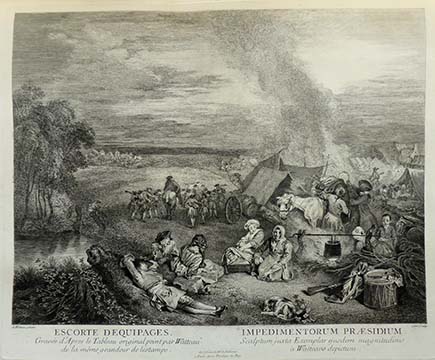
Laurent Cars after Watteau, L’Escorte d’équipages, engraving, c. 1731.
L’Escorte d’équipages was engraved in reverse by Laurent Cars. The engraving was announced for sale in the April 1731 issue of the Mercure de France.
Dacier, Vuaflart, and Hérold note that Cars’ engraving was copied in an engraving in the opposite sense by Claude du Bosc, and was sold in England under the title Convoy of the Equipage.
PROVENANCE
Paris, collection of Jean de Jullienne (1686-1766; director of a tapestry factory). Jullienne’s ownership is noted on the engraving: “du Cabinet de M. de Julienne.” Mariette, “Notes manuscrites,” cited the painting as “un merveilleux tableau, qui est dans la cabinet de M. de Jullienne.”
Mantua and Rome, collection of Cardinal Silvio Valenti Gonzaga (1690-1756). The painting is cited in the posthumous 1756 inventory (Mantua, Biblioteca Comunale, Misc. 109/11, “Catalogo de’ quadri, tuttavia esistenti nella galleria della Ch. Mem. Dell’E.mo Sig. Cardinale Silvio Valenti”), listed under cat. 484: “Quadro di palmi 1., one 10. per larghezza. e palmi 1., once per altezza rappresentante un Accampamento di Soldati, in tavola, di Antonio Watteau.” The inventory number 484 remains on the reverse side of the panel.
By descent to Cardinal Silvio Valenti Gonzaga’s nephews, Marques Carlo Valenti Gonzaga (d. 1783) and Cardinal Luigi Valenti Gonzaga (1725-1808). Sold from the latter’s estate in 1818 to Pietro Camuccini.
Rome, collection of Pietro Camuccini .1761-1833). By descent to his nephew Giovanni Battista Camuccini.
Rome, collection of Giovanni Battista, Baron Camuccini (1819-1904). By descent in the Camuccini family.
New York, sale, Christie’s, January 28, 2009, lot 89: “Jean Antoine Watteau . . . Escorte d’équipages, oil on panel, 11 ¼ x 12 3/8 in. 28.2 x 31.4 cm. est. $800,000-1,200,000. Provenance . . . Literature . . . “ Bought in.
Vienna, sale, Dorotheum, October 17, 2012, lot 628: “Jean Antoine Watteau . . . Escorte d’Equipages / Öl auf Holz 28.2 x 31.4 cm gerahmt. €250,000-3000,000 (US $301,900 -362,300). . . . “ Bought in.
Vienna, sale, Dorotheum, October 21, 2014, lot 111: “Jean Antoine Watteau . . . Escortes d’Equipages. . . Est. €120,000-180,000 (US $160,500-240,800).” Bought in.
Vienna, sold privately by previous owner to Lionel Sauvage in 2020.
EXHIBITIONS
New York, Frick Museum, Watteau’s Soldiers (2016), cat. 52
Frankfurt, Städel Museum, Watteau der Zeichner (2016), cat. 17
SELECT BIBLIOGRAPHY
Hédouin, “Watteau” (1845), cat. 78.
Hédouin, Mosaïque (1856), cat. 79.
Goncourt, L’Art au XVIIIème siècle (1860), 56.
Goncourt, Catalogue raisonné (1875), cat. 56.
Mollet, Watteau (1883), 62.
Phillips, Watteau (1895), 27.
Dilke, Watteau (1899), 79.
Séailles, Watteau (1901), 62, 72.
Josz, Watteau (1904), 56.
Pilon, Watteau (1912), 22, 84
Dacier, Vuaflart, and Hérold, Jean de Jullienne et les graveurs (1921-29), 1: 262; 2: 34, 95, 97, 122, 151, 158 ; 3: cat. 125.Réau, “Watteau” (1928), cat. 49.
Adhémar, Watteau (1950), cat. 39.
Cailleux, “Four Studies of Soldiers“ (1959), n.p.
Mathey, Watteau, peintures réapparues (1959), 67.
Macchia and Montagni, L’opera completa di Watteau (1968), cat. 57.
Roland Michel, Watteau (1981), cat. 92.
Roland Michel, Watteau (1984), 96, 167-70, 266, 300.
Washington, Paris, Berlin, Watteau 1684-1721 (1984), under cat. D 34.
Posner, Watteau (1984), 34, 40.
Rosenberg and Prat, Watteau, Catalogue raisonné des dessins (1996), cat. 179-81, 301-02,
London, Royal Academy, Watteau, the Drawings (2011), under cat. 32.
Michel, Le «célebre Watteau» (2008), 259.
Wile, Watteau’s Soldiers (2016), cat. 20, 22-23, 25, 30-31, 52
RELATED DRAWINGS
Despite the many figures in L’Escorte d’équipages, especially in the background, only a few preliminary drawings are known and they are all for figures in the foreground of the picture.
A sheet in the Boijmans Museum (Rosenberg and Prat 180) provided the artist with the figure of the sleeping soldier that anchors the right side of the picture. The soldier behind him in the painting, resting his chin in his hand, was taken from another sheet with studies of soldiers, this in the École des beaux-arts (Rosenberg Prat 179).
For the woman reclining in the foreground, seen from behind, Watteau relied on a sheet in the British Museum showing her in five similar but alternative positions (Rosenberg and Prat 181). For the aged woman (apparently not the mother, who is next to her), Watteau used a study now in the Prat collection. Unlike most of his rapid drawings from the model which he used for his paintings, this sheet belongs to a series of strong, carefully executed “popular” genre types that seem destined for another purpose. Is early use of trois crayons also distinguishes it.
Toward the left side of the painting, the young boy with his hands in his apron, presumably an assistant to the cook, was based on a study now in the British Museum (Rosenberg and Prat 302).
REMARKS
Throughout the nineteenth and twentieth centuries, it was presumed that L’Escorte d’équipages was lost. Since its rediscovery in 2009 there has been unanimous acceptance of the picture, something rare in the field of Watteau studies.
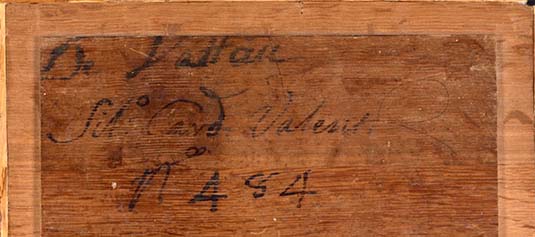
No one had suspected that it had been hidden away in Italian private collections. The inscription on the back of the painting proves its presence in the well-known and much-celebrated Gonzaga collection. That Watteau’s painting went to Italy soon after the artist’s death is surprising but not unique, since other paintings similarly left France in the first decades of the eighteenth century, for Spain, England, Germany, and the Netherlands.
Like most Watteau paintings, this picture has suffered some damage over the course of the last three centuries. Although there is some overpainting, in general the surface is only lightly abraded. Far more serious is that it has been cut at the lateral edges. Approximately a fourth of the painting—all landscape—was removed at the right. A comparison of the painting with Cars’ engraving shows that a strip of about six centimeters of landscape has been cut off at the left side of the painting. The dimensions recorded in the Valenti Gonzaga inventory indicate that the panel had already been cut in 1756, perhaps to pair it with another work or in an effort to make the composition more symmetrical.
Following a long-standing tradition that dates all of Watteau’s military subjects to the period when he traveled back to Valenciennes, so too this painting had been placed in that time period. Previously that trip was thought to have taken place in 1709, and Watteau’s military subjects were dated on that basis. Thus Adhémar, Montagni and Macchia, and Roland Michel dated L’Escorte d’équipages to 1710, while Mathey and Cailleux preferred 1712. However, Hattori’s 2004 discovery of the artist’s passport revealed that the trip did not occur until 1710, setting the time for his military subjects forward by a year. Moreover, in recent years there has been a still more fascinating revision of the issue because some of the preliminary drawings have been dated still later, to 1715. It is now believed that the study of the boy in an apron and the mother beside the child in a rocking crib are more strongly delineated and evidently later than the studies for the soldiers. So too, the drawing of the woman lying on the ground, seen from behind, is equally late. Thus Rosenberg and Prat, Grasselli, and Wile have accepted the implication that L’Escorte d’équipages also dates to c. 1715. This changes the normally accepted chronology for Watteau’s oeuvre by postulating that he executed some military subjects just a year or two before his Pèlerinage à l’isle de Cythère.
For copies of L’Escorte d’équipages CLICK HERE
